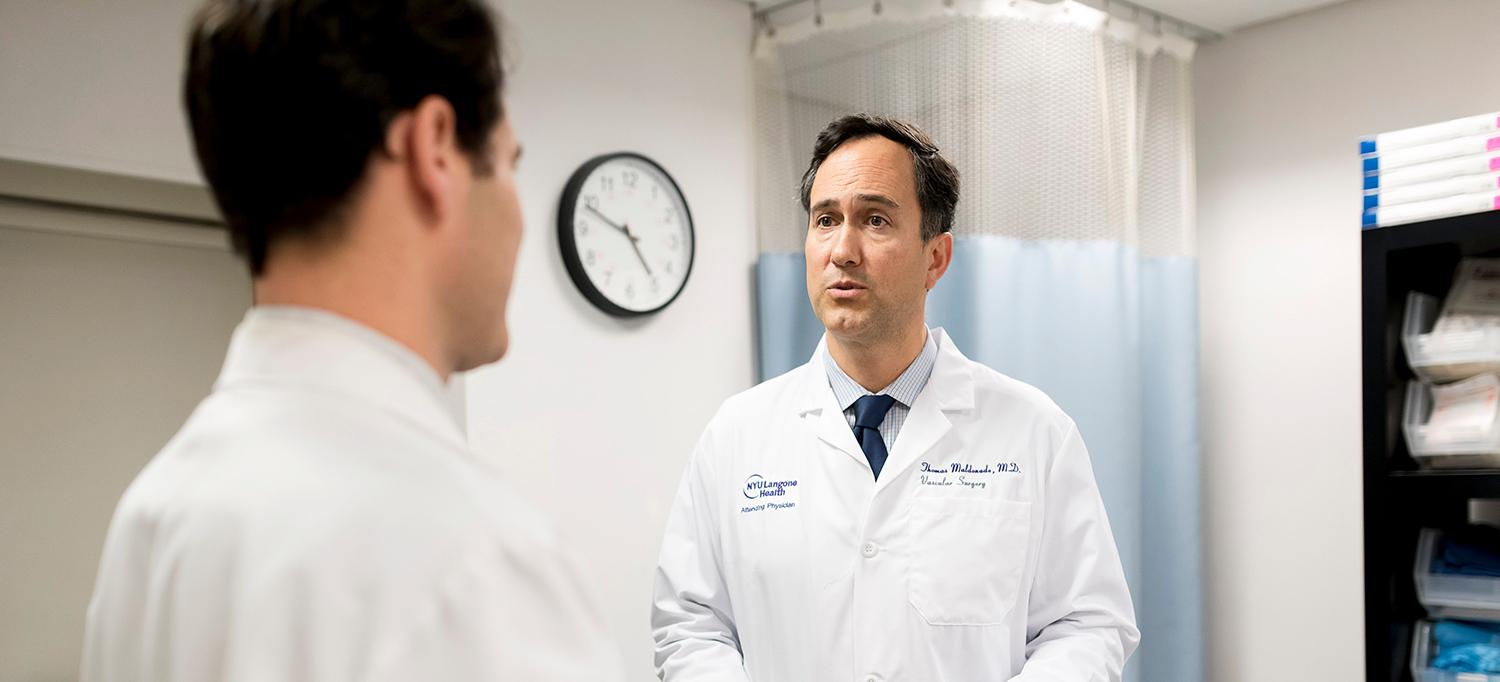NYU Langone Vascular Surgeons Share Insights About Advanced Endovascular Treatment

Dr. Thomas Maldonado is leading efforts to develop devices that provide more advanced treatment for peripheral vascular diseases.
Photo: Karsten Moran
NYU Langone Health is pioneering novel devices for treating peripheral vascular diseases, as well as a new, minimally invasive system for creating arteriovenous fistulas for kidney dialysis—while providing patients with world-class care.
Leading the Way in Endovascular Aneurysm Repair
In 2018, the Aortic Disease Center at NYU Langone piloted two new stent grafts designed to treat aneurysms that involve multiple branches of the thoraco-abdominal region.
Studies involving these new devices, led by Neal S. Cayne, MD, professor of surgery and director of endovascular surgery, and Thomas Maldonado, MD, the Schwartz Buckley Professor of Surgery and co-director of the Aortic Disease Center, build on the Aortic Disease Center’s innovation in endovascular aneurysm repair (EVAR) since it tested some of the first endografts 25 years ago.
“Because each patient’s anatomy differs, a wide range of graft configurations is required to repair aneurysms without blocking essential arteries,” explains Dr. Maldonado, who is also medical director of the Venous Thromboembolic Center. “We’re partnering with industry to develop devices that bring the benefits of EVAR to more patients with complex aneurysms.”
One of those investigational products is a next-generation system from Cook Medical featuring a fenestrated or branched main graft that can be custom designed for each patient by attaching additional grafts to stent the mesenteric, celiac, and renal arteries.
“Because each patient’s anatomy differs, a wide range of graft configurations is required to repair aneurysms without blocking essential arteries.”—Thomas Maldonado, MD
“We’ve implanted these in six patients so far, and they’ve done exceptionally well despite severe comorbidities,” says Dr. Cayne. “With this minimally invasive approach, they’re out of the hospital in an average of two days.”
The Aortic Disease Center is also one of only five sites in the nation to pilot the Medtronic Valiant™ Manifold stent graft—a unique off-the-shelf device featuring four arms that can be used to selectively stent vessels. Unlike custom devices, which take several weeks to manufacture, this branched graft requires little lead time before deployment, making it a potential lifesaver in emergent situations. It also allows the surgeon extraordinary flexibility in staging, to best fit the patient’s tolerance. Five patients have received this device at NYU Langone to date, with encouraging results.
New Approaches to Deep Venous Outflow Disease
Deep venous obstruction affects an estimated 24 million people worldwide, increasing their risk of dangerous blood clots and leading to symptoms ranging from varicose veins to debilitating pain, swelling, and ulceration of the legs.
Although the therapy of choice is stenting of the iliac vein, no device designed specifically for that purpose has been approved by the U.S. Food and Drug Administration (FDA). Instead, the most common approach has been off-label use of the braided-Elgiloy® WALLSTENT™ Endoprosthesis, whose high degree of flexibility and compressibility can be problematic under some circumstances—resulting in foreshortening, narrowing, or inaccurate deployment.
NYU Langone is on the forefront of efforts to develop superior alternatives. “We’ve been involved in trials for all the dedicated vascular stents now coming to the market,” notes Todd L. Berland, MD, associate professor of surgery and director of Outpatient Vascular Interventions. “The goal is to find a device that will maintain the correct length, the correct width, and stay exactly where you put it.”
Dr. Berland is currently a principal investigator of the Abre venous self-expanding stent system by Medtronic, a Nitinol-based device designed to achieve a better balance of strength, flexibility, and deployment accuracy. Patients began receiving these stents in October. In addition, Mikel Sadek, MD, assistant professor of surgery, has been a principal investigator for the VICI Venous Stent™ self-expanding system by Boston Scientific, also a Nitinol-based device designed to achieve similar benefits.
New Hemodialysis Technique Offers Greater Ease—and Effectiveness
Nearly 500,000 people in the United States currently receive hemodialysis for end-stage renal disease. For more than 50 years, arteriovenous (AV) fistulas have been installed surgically in an operation that typically takes more than an hour, with failure rates of up to 60 percent. In 2018, Dr. Berland launched a national trial of the WavelinQ™ endoAVF System, which aims to reduce that time to a few minutes and produce far more consistent results.
With the new technique, two flexible magnetic catheters are inserted into an artery and vein in the arm. A tiny pulse of radiofrequency energy is then used to connect the two vessels, creating the fistula. After the catheters are withdrawn, a brachial vein is coil-embolized, completing the procedure.
In 2016, Dr. Berland became the first surgeon in the world to create an AV fistula using the latest generation of this system, operating on a patient in Paraguay. In 2017, he co-presented the results of the single-arm, prospective, multicenter Novel Endovascular Access Trial (NEAT) at the Leipzig Interventional Course (LINC) in Germany. The study found that the procedure caused less pain and scarring than open surgery and that its re-intervention rate was four to five times lower.
Recently, in 2018, Dr. Berland completed a Paraguay-based study of a smaller version of the everlinQ® device, with equally encouraging results, and he has submitted a manuscript for publication. “These methods have a success rate of approximately 90 percent and are easier on the patient,” Dr. Berland says. “We think they could revolutionize the way patients receive dialysis.”

